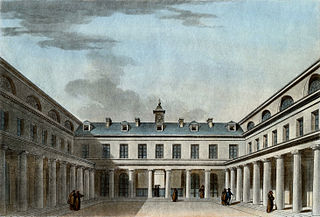Related Research Articles

The Prix de Rome or Grand Prix de Rome was a French scholarship for arts students, initially for painters and sculptors, that was established in 1663 during the reign of Louis XIV of France. Winners were awarded a bursary that allowed them to stay in Rome for three to five years at the expense of the state. The prize was extended to architecture in 1720, music in 1803 and engraving in 1804. The prestigious award was abolished in 1968 by André Malraux, then Minister of Culture, following the May 68 riots that called for cultural change.

The Société Mathématique de France (SMF) is the main professional society of French mathematicians.

France competed at the 1936 Summer Olympics in Berlin, Germany. 201 competitors, 190 men and 11 women, took part in 100 events in 18 sports.

The Lycée Condorcet is a school founded in 1803 in Paris, France, located at 8, rue du Havre, in the city's 9th arrondissement. It is one of the four oldest high schools in Paris and also one of the most prestigious. Since its inception, various political eras have seen it given a number of different names, but its identity today honors the memory of the Marquis de Condorcet. The school provides secondary education as part of the French education system. Henri Bergson, Horace Finaly, Claude Lévi-Strauss, Marcel Proust, Jean-Luc Marion, Francis Poulenc and Paul Verlaine are some of the students who attended the Lycée Condorcet.

Théâtre Hébertot is a theatre at 78, boulevard des Batignolles, in the 17th arrondissement of Paris, France.
Christian Gérard Mazas, known as Christian-Gérard, was a French stage and film actor as well as theater director.

The Théâtre Édouard VII, also called théâtre Édouard VII – Sacha Guitry, is located in Paris between the Madeleine and the Palais Garnier in the 9th arrondissement. The square, in which there is a statue of King Edward VII, was opened in 1911. The theatre itself, which was originally a cinema, was named in the honour of Edward VII, as he was nicknamed the "most Parisian of all Kings", appreciative of French culture. In the early to mid 1900s, under the direction of Sacha Guitry, the theatre became a symbol of anglo-franco friendship, where French people could discover and enjoy Anglo Saxon works.
The prix Broquette-Gonin was a former prize awarded by the Académie française.
References
- ↑ Coste, Alain; Cony, Christophe (July–August 2018). "1940: Émile Becquet, l'as qui en cachait un autre". Avions (in French). No. 224. pp. 68–77.
- ↑ Hugot, Bernard (July–August 2018). "Un grand as Français Libre: Michel Boudier, "l'homme à la pipe"". Avions (in French). No. 224. pp. 30–46.
- ↑ Cony, Christophe (July 2002). "Marcel Lefèvre, un héros du "Normandie"". Avions (in French). No. 112. pp. 4–13.
- ↑ Philippe, Bernard; Cony, Christophe (May–June 2009). "Michel Madon, L'"As" Dijonnais". Avions (in French). No. 169. pp. 4–17.
- ↑ Phillipe, Bernard (October 2004). "François Morel : 11 victoires en 9 jours". Avions. No. 139. pp. 6–17.
- ↑ Coste, Alain (March 2003). "Maurice Romey: As du GC III/2 et chasseur par accident". Avions: Toute l'Aéronautique et son histoire (in French). No. 120. pp. 9–15.
- Méchin, David (February 2021). "James Denis: Le premier as de la France libre: Première partie". Le Fana de l'Aviation (in French). No. 615. pp. 14–26. ISSN 0757-4169.
- Méchin, David (March 2021). "James Denis: Le premier as de la France libre: Deuxième partie". Le Fana de l'Aviation (in French). No. 616. pp. 68–76. ISSN 0757-4169.